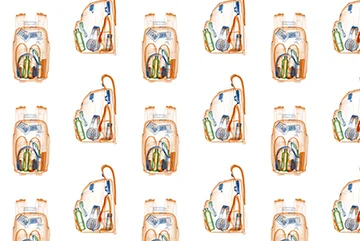UXytocin – The Neuroscience of Trust in UX
Murtaza Khalil /
Before we get into the details let’s break it down
What is neuroscience?

Neuroscience or neurobiology is the scientific study of the nervous system. It is a multidisciplinary branch of biology that combines physiology, anatomy, molecular biology, developmental biology, cytology, mathematical modelling, and psychology to understand the fundamental and emergent properties of neurons and neural circuits.
What is trust?

Well like most things trust has multiple definitions, let’s have a look at some of them:
Trust is what you need when you cannot predict, or do not have confidence in, behaviour and outcomes. – Sociologist Adam Seligman
Trust is the assured reliance on the character, ability, strength, or truth of someone or something- Merriam Webster
Trust is believing that the person who is trusted will do what is expected. It starts at the family and grows to others – In psychology
The degree to which one party trusts another is a measure of belief in the honesty, fairness, or benevolence of another party – In sociology
What we do know for sure is that trust is a feeling and human beings feel a particular way when they trust. All feelings are born of a chemical reaction in the human body. Hence in 2017 Paul J. Zak, a researcher on the cutting edge of the new field of neuroeconomics and a professor of economics, psychology, and management hypothesized that there must be a neurologic signal that indicates when we should trust someone. So he started a long-term research program to see if that was true.
Through his research, he successfully demonstrated that a display of trust or trustworthiness by an individual was accompanied by a release of oxytocin, a powerful natural chemical, in their bodies. Vice versa, he discovered that the safe administration of doses of synthetic oxytocin into living human brains, through a nasal spray, led to a substantial increase in trust and trustworthiness by participants of the study.
He found that a greater amount of trust or trustworthiness on the part of a participant was accompanied by a greater release of oxytocin in their brains. Establishing a direct relation between oxytocin, trust and trustworthiness.
He also found that a higher amount of trust, on part of a trustee, was accompanied by a higher amount of trustworthiness, on the part of the trusted.
Using a variety of psychological tests, he showed that those receiving oxytocin remained cognitively intact. He also found that they did not take excessive risks in a gambling task, so the increase in trust was not due to neural disinhibition. Oxytocin appeared to do just one thing—reduce the fear of trusting a stranger.
Experiments around the world have shown that humans are naturally inclined to trust others—but don’t always.
Now that we know what Trust is, let’s see why it is beneficial to build an experience for trust:
1. Promotes Positive Emotions

Research has shown how intimately oxytocin, the trust hormone, is connected with positive emotional states and the creation of social connections. It’s well documented that animals become calmer, more sedate, and less anxious when injected with oxytocin. The same positive emotions would be experienced by human beings when they partake in an experience they trust.
This means if a user trusts your product or your brand, they come in primed to have a positive experience and are much more likely to have one as opposed to if they used a product or brand they do not trust.
2. Increases Empathy

In his research, Professor Paul J Zack, also discovered that oxytocin increases a person’s empathy, a useful trait for social creatures trying to work together. More trust = more oxytocin = more empathy.
More empathy towards an experience would mean more leeway by a user towards negative experiences, this means more chances for a company to make mistakes and be forgiven, this means more space for a company to make riskier decisions with regards to the experience they want to offer as they will have more chances to hit and miss and still be liked by their user. However, it should be noted that trust can slowly but surely be eroded over time and this advantage should not be taken advantage of.
Thus more empathy would lead to a better understanding and a forgiving attitude towards negative experiences such as late deliveries, mistakes in order completion, app downtime, unclear networks, long processes etc. Meaning, higher stickiness of a product leading to higher completion rates, lower dropoffs and better ratings.
3. Faster adoption of Change and the New

As trust grows more and more people are willing to move towards purchasing electric vehicles like TESLA
Trust is integral to the idea of social influence, it is easier to influence or persuade someone who is trusting. The notion of trust is increasingly adopted to predict acceptance of behaviours by others, institutions (e.g. government agencies) and objects such as machines. Likewise, people are more accepting of people, institutions, etc. That they trust.
More trust will mean easier and faster adoption of big changes and innovations in a product. It is extremely hard to break habits people have already developed over time, even if the newer option is much better for them, and if the habit is broken forcefully, this could lead to a lot of frustration and other negative emotions that could cost a company its users. At the same time, there is the fear that a new, younger product may come into the market and take away a companies market share by offering a more innovative product without having to worry about maintaining its current relationships with its existing users.
This is where trust comes in. Take Apple, for example, it is repetitively able to introduce highly innovative and different products that its user have been critical of due to the extreme change in usage behaviour, like the AirPods, but time and time again Apple users stick it out with the newly introduced products and grow to like and love them.
4. Reduces Stress

High stress is a potent oxytocin inhibitor. Which now we know is the trust chemical. Most people intuitively know this: When they are stressed out, they do not interact with others effectively due to it. Inversely oxytocin release leads to a reduction of stress. People in trusting relationships suffer from much lower levels of chronic stress. This means that a user will not be stressed if he is interacting with something or someone that he trusts and may even be de-stressed by the interaction.
This tells us that it is very important for products like yoga apps that try to de-stress people or education apps that help students through an otherwise very stressful experience to be trustworthy and build a lot of trust between themselves and their users.
5. Increases loyalty
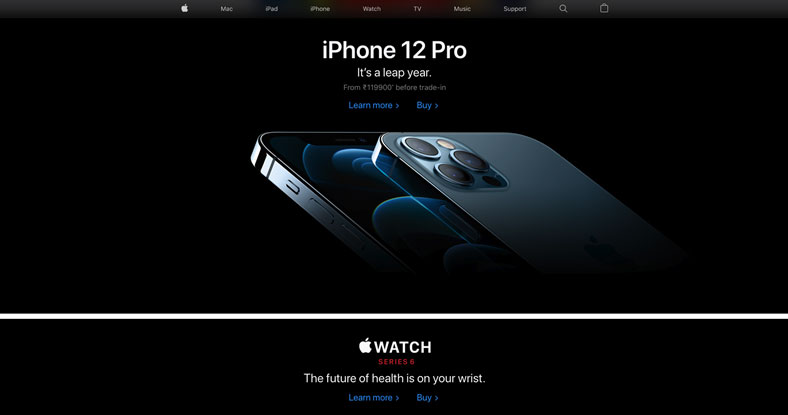
Apple is said to have one of the worlds most loyal customer base
People in high trust relationships are more loyal and stay in said relationships much longer. Users will stick to a product that does not have the best experience because they trust the experience and have become familiar with it. Increased loyalty will drive a lot of repeat business to a company and its products. Hence a much larger customer lifecycle value making it cheaper for the company to invest larger amounts of time, effort and money on customer acquisition. It would also lead to an increase in brand ambassadors, directly leading to more natural recommendations of the product and increasing the existing user base.
6. Reduces Anxiety

Studies with human subjects have shown that oxytocin reduces anxiety and neuroendocrine responsiveness to social stressors. Remember that feeling you sometimes have when you are on an unfamiliar payment service trying to transfer money? Having to check the amount and other details a multitude of times, maybe even sending a test amount just to see everything works and eventually even abandoning the transaction in some cases. Alternatively, do you remember the feeling when you transfer money over a site you trust like Amazon or Swiggy? Much easier isn’t it? This is since they have already built up a lot of trust with you and you are now more open to interacting and transacting with them.
So clearly a decrease in anxiety can mean more process completions as well as higher completions even in cases a task may have some steps that a user finds unreasonable or may not see the need for.
7. Increased Investment
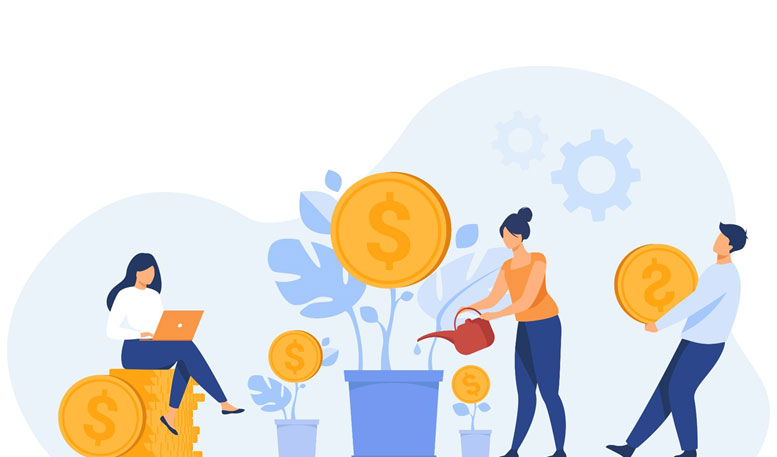
Trust in a business motivates investment. It has been discovered that levels of trust in social, economic and institutional environments influenced decisions to invest. Businesses verified as trustworthy by trusted sources attracted bigger investments.
A trustworthy experience with a business would lead to increased investment in the business by all kinds of stakeholders. For example, employees would spend more effort maintaining and improving the product, stockholders would increase their share in the business, customers would spend more of their money on the business.
Similarly, when it comes to the trust in a particular product, all stakeholders would invest more into it hence leading to a synergistically stronger push for the experience in the correct direction. Taking the example of an e-commerce platform, vendors would be more willing to register their products at better terms, customers would be willing to pay higher prices after spending less of their time deciding about a purchase, all participants would be more open to feedback from each other, etc.
Clearly, trust is very valuable and needs to be given a lot of importance. Now to see how we can actually build an experience users will trust:
1. Leverage existing user Mental Models

Websites keep the option to log in and sign up in the top right corner where users most expect to find it.
In UX a mental model is a set of already existing beliefs a user has about how a user interface will function if they interact with it based on their current knowledge or experience.
Kenneth Craik suggested in 1943 that the mind constructs “small-scale models” of reality that it uses to anticipate events. Somewhat like browser cookies, that help the browser load pre-visited pages faster by remembering what it has seen the last time it opened the page.
The best way to build trust is through predictability since trust, as we have learnt, comes out of a match between user expectations and actual happenings. The more an instance behaves differently from what a user expects the more trust may be eroded.
In the context of interface design, this means we should use as few new elements in an interface as possible so the user does not have to think every time he wants to perform an action or consume material. All similar actions should work similarly. In a case a new instance, that does not already commonly exist, needs to be created, it should be created keeping in mind existing user expectations.
For this we must define and Identify our target user, then research what kind of interfaces exist in their ecosystem and which they like and dislike the most, use these interfaces as a reference to build a product the user will know how to use before interacting with it even once, allowing him to trust the product at first use itself.
2. Be Transparent
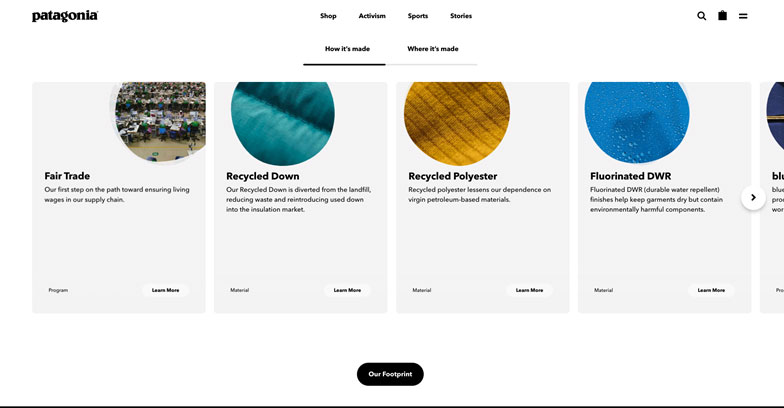
PATAGONIA provides complete transparency about how and where its products are made
Transparency, as used in science, engineering, business, the humanities and in other social contexts, is “operating in such a way that it is easy for others to see what actions are performed”. Transparency implies openness, communication, and accountability.
As per a 2015 study, 2.5 million manager-led teams in 195 countries found that workforce engagement improved when supervisors were more transparent due to an increase in trust. Sharing information broadly reduces chronic stress, which inhibits the release of oxytocin and leads to an untrustworthy environment. Openness is the antidote, it reduces uncertainty, improves predictability and promotes a healthier mental state.
So next time you design something and are not sure if the user requires a particular set of information and if you should share it with them, share it! Transparency does not mean a user should be shown all the information all the time, it simply means if the user may have a need or want of something try to make it available somehow. To boost transparency you should try to answer the user’s questions before he asks them, have a FAQ’s section, have a helpful chatbot so the user can have his questions answered immediately without a long wait to get in touch with a call centre executive, etc.
3. Use Social proof

Social proof is a term coined by Robert Cialdini in his 1984 book, Influence, is also known as informational social influence. It describes a psychological and social phenomenon wherein people copy the actions of others in an attempt to undertake behaviour in a given situation.
The effects of social influence can be seen in the tendency of large groups to conform. This is referred to in some publications as herd behaviour. Although social proof reflects a rational motive to take into account the information possessed by others, formal analysis shows that it can cause people to converge too quickly upon a single distinct choice, so that decisions of even larger groups of individuals may be grounded in very little information
Similarity also motivates the use of social proof; when a person perceives themselves as similar to the people around them, they are more likely to adopt and perceive as correct the observed behaviour of these people. This has been noted in areas such as the use of laugh tracks, where participants will laugh longer and harder when they perceive the people laughing to be similar to themselves.
We’re wired to want to collaborate with friends. People prefer to tackle challenges with friends than strangers. Researchers at Rutgers University ran an investment game experiment and found participants chose to invest more frequently with their friends than with an associate or computer, despite equal success rates.
When an investment risk paid off, MRI scans showed two parts of the brain associated with wellbeing and trust lit up more when people had chosen a close friend.
We’re far more likely to trust people who are similar to us in some dimension. Perhaps the most compelling evidence of this comes from a study by researcher Lisa DeBruine. She developed a clever technique for creating an image of another person that could be morphed to look more and more (or less and less) like a study participant’s face. The greater the similarity, DeBruine found, the more the participant trusted the person in the image. This tendency to trust people who resemble us may be rooted in the possibility that such people might be related to us.
Other studies have shown that we like and trust people who are members of our own social group more than we like outsiders or strangers. This in-group effect is so powerful that even random assignment into small groups is sufficient to create a sense of solidarity.
The same has been realised by a Nielson Norman survey about trust in advertising.

In e-commerce, social proof can be defined as a testimonial of the good service provided to previous customers, who leave a positive review on your page or refer it to others. Just like we have seen earlier, people are more likely to make a purchase if they hear it from their friends and family. Online store owners showcase real-time purchasing on their website to entice potential new customers to buy their products.
Social proof is also prominent on social networks such as Twitter, Facebook, Instagram and YouTube. The number of followers, fans, views, likes, favourites and even comments that a user has made, positively affects how other users perceive them. A user on Twitter with a million followers is perceived as more trustworthy and reputable than a similar user with a thousand followers, resulting in faster growth of followers and higher engagement and click-through rates.
4. Use Authority, Borrow Trust from those who already have it

A Trinity Mirror and Ipsos survey revealed that 42% of people distrust brands and 69% of people distrust advertising. This is in stark contrast to the 83% of consumers that trust recommendations from their peers.
Refer to the following statistics measuring user trust based on the credibility of experts and peers.

As you can see users trust technical experts the most followed second by academic experts and then people like themselves when it comes to judging the credibility of information they have received. It’s also worth noting here that celebrities came in the last place in terms of credibility, an interesting finding considering how many brands still use them in their campaigns.
This makes apparent the fact that it is beneficial to highlight and leverage community experts and peer voices as brand spokespeople to endorse and promote your products where possible.
This can be especially useful for products that have high levels of technical complexity, for example, medicines are often endorsed by well-known people in the medical field, same when it comes to selling the nutritional value of food products.
5. Having a Human Tonality of Interface

Replika is a chatbot that aims to provide users with a digital companion that is as human as possible
Research has shown that human beings are naturally predisposed to trust one another. Hence having a human tone for interface content would make it easier for a user to trust an experience. This is has been very successfully been used in voice interfaces for example Amazon is continuously using AI to make Alexa, its voice assistant, sound as humanlike as possible. Not only that, they have now made it possible for a user to select from a range of human voices such as Samuel Jackson so the user can select the one they prefer. This instantly improves the chances of a user trusting an interface more than an interface that has a mechanical tone for its content.
The same should be done when it comes to written, visual and other types of experiences as well. A great way to further strengthen the brand’s personality would be to have an avatar and a chatbot that users can use to converse with the brand to meet their wants and needs. Write with empathy so the user knows you understand them. This is also a great way to differentiate from the competition and stand out.
6. Utilise an Aesthetic and Attractive interface

The aesthetic-usability effect refers to users’ tendency to perceive attractive products as more usable. People tend to believe that things that look better will work better and are also generally perceived to be easier to use and are regarded as more valuable than ugly ones. — even if they aren’t more effective, efficient or usable. This is also why we so often judge books by their covers.
This is why a good looking interface that does not otherwise have a great experience is still often perceived as trustworthy and of premium quality. Of course, this realistically helps best when the experience is great as well. If backed by a sub-par experience the user may eventually grow to dislike the experience and the trust gained through being visually appealing will be lost before long.
Designing an aesthetically pleasing experience can be achieved by first researching your target audience to figure out what they’ll deem attractive. Conduct studies to gain an understanding of the people your product is meant for and uncover their aesthetic preferences. Then, keeping the outcome in mind, design a product that will appeal to your target audience visually.
7. Put resources into Security and be Vocal about it

DBS BANK is well known for its security because it consistently markets this aspect of its product
Provide security. Make it so the user does not need to worry about using your site. Apple, and nearly every other big name in the IT industry, is fighting federal agencies such as the FBI so that customers can safely store their private information with them. Every software vendor works hard against bugs and hackers to keep the trust of their customers. This is because they are very aware of the fact that once trust is lost it is much harder to regain than it would have been to maintain.
Once you have done your part in providing the user with security, let them know about it. There is no point in being the most secure site in existence and not being vocal about it, not only will this increase user’s trust in you, but it is also beneficial to them as they are now aware of the safety of a feature you may have built to be very safe. For example, a digital money transfer journey with two-step verification is much safer than practices that only utilise a single step but end up being a longer journey so vocalise the fact that this is because you have designed the journey to be extra safe as competitors. Not only will this mean users will be more forgiving of the longer journey but they will feel safer and trust the product more, which in the money transfer ecosystem is extremely important to users.
To build trust in this way, follow practices like adding security labels and images to your landing pages and checkout flows, make the user aware you have gone the extra mile to keep them safe. Showing someone that your website is secure and that their data is safe if entered into your website will build a positive relationship between you and them.
8. Ask for User Feedback
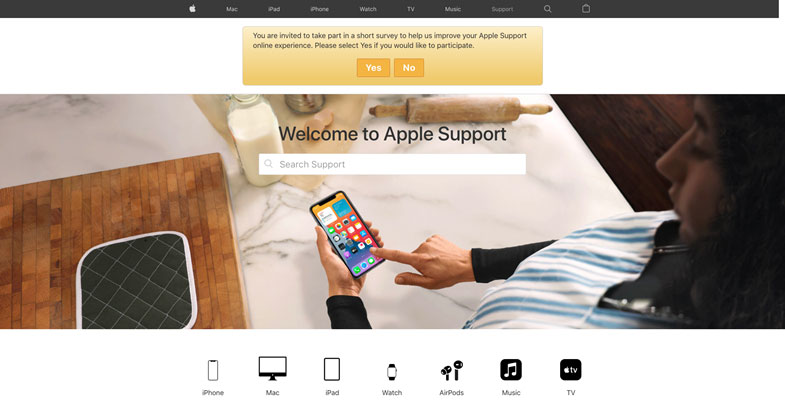
Apple generating a pop-up asking a user for feedback.
User Feedback is the information you get from a user about an experience they have had relating to a product, event, process, etc. It could be either positive or negative.
Research has found that showing vulnerability(The quality or state of being exposed to the possibility of being attacked or harmed, either physically or emotionally), for example by asking for help, stimulates oxytocin production in others, increasing their trust and cooperation.
Jim Whitehurst, CEO of open-source software maker Red Hat, has said, “I found that being very open about the things I did not know actually had the opposite effect than I would have thought. It helped me build credibility.” Asking for help is effective because it taps into the natural human impulse to cooperate with others.
Listen to your users and let them build the product with you, they will feel invested in the product. Even if the answer is obvious sometimes it is good to ask for help, to let the users feel involved, and you might be surprised by the number of great ideas your users have to share with you. Listening to a user is the superpower of any UX designer. And don’t stop there, once your product has been produced make sure there is an easily available channel for users to share users feedback with you in whatever mode they wish. Don’t force a user to type feedback out, maybe they prefer to share an audio note or a small video with you since they find it easier to do? Make these modes of feedback collection available. This will make sure you keep improving your product while staying ahead of the competition. It will also prevent you from turning into a laggard product that has gotten old only to be replaced by a younger competitor with new features and other innovations.
9. Provide Support
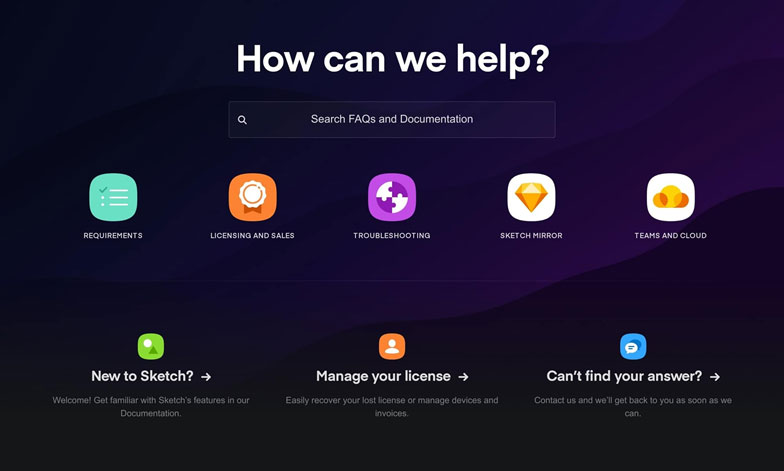
Wu and Parker (2017) found that offering “secure-base support” facilitated higher levels of autonomous motivation and proactive work behaviour in employees. This has been found to be true in various other situations as well for example couples who feel their partners are more supportive of their wishes tend to stay together much more than those who don’t. Similarly, it can be hypothesized that a user will trust a product much more if it provides timely and easy to access support.
One of the most important reasons human beings are soo prone to trust is because they need stability,
Stability builds trust, stability comes from knowing there will be someone to pick you up when you fall, show the user that u will be there for him when something goes wrong. This is why human beings generally trust their own families more than any other people. Here as well it is very important for support to be available through different channels such as tutorial support, chat support, voice call support, video call support,
10. Recognize and Reward excellence

Neuroscience shows that recognition has the largest effect on trust when it occurs immediately after a goal has been met, when it comes from peers, and when it’s tangible, unexpected, personal, and public. Public recognition not only uses the power of the crowd to celebrate successes but also inspires others to aim for excellence. And it gives top performers a forum for sharing best practices, so others can learn from them.
This is often seen taking place on sites like LinkedIn where professionals will share their achievements and will get instant feedback from peers as well as in games where as soon as the player has achieved any of the many goals they are alerted about it in a celebratory fashion and are then even allowed to share this with their peers which indirectly also leads to natural referrals of the product. This builds the users trust in the experience and keeps them coming back for more knowing they can expect a similar reward again.
This is also used very effectively in fitness apps where users are allowed to easily share their progress with their peers and be rewarded in the form of likes, hearts, etc. Maybe they could even be rewarded with a free workout day at a partner gym.
11. Build a Brand

Build trust in the brand the user is interacting with. If a user trusts the brand associated with a product, they will also trust a product of that brand. Hence companies should use methods like social proof etc to build trust in a brand and then leverage it for any product of the company.
This has worked very successfully for giants like TATA and Tesla who can launch a product and have a considerable number of expected sales just due to how much their customers trust them. This is a huge boon for companies that have multiple products as they can concentrate marketing expenditure on their brand and avail the value of an increased brand value on all products associated with the brand. This also means a much smaller risk when launching new products or features as users are much more likely to adopt a new product/feature from a brand they trust. It also helps users easily predict the quality of an experience they can expect for example if you see the TATA brand on a product you can safely assume the quality will be good without having to do any further due diligence.
12. Have clear Navigation

As defined earlier trust is when the trusted, behaves as expected of them by the trustee. Based on this it is clear that for a navigation model to be trustworthy it should do as the user expects it to. This means the navigation should firstly make it clear to the user what will happen if he navigates in a particular way, this can be done with a clear and more detailed call to action points and an intuitive IA. Navigation should tray and follow existing user mental models. It should be very easy for a user to route to any part of his journey from his current location whether it be a point in his past journey through practices like breadcrumbs, or to any part of a product with the help of a universal search. Once a user has navigated to a page it should be very clear to him where he is in the context of why he is at this page as well as in the context of where he is in the entire universe of the product he is using.
Good navigation has far-reaching advantages from more sign-ups and conversions to higher product adoption rates. For example, Google’s extremely simple and clear search-based navigation allows for extremely easy and intuitive browsing of the internet. Similarly, chatbot navigation of a product has also been found to be extremely intuitive, and voice assistants, even more so.
13. Allow users to Socialize

FITBIT has a created a community for its users
Positive social interactions also increase oxytocin levels. Researchers have found that your brain releases more oxytocin during social contact and social bonding, and this can speed up healing from disease. Even just connecting through social media can increase oxytocin! It doesn’t necessarily need to be in person, although that’s definitely better.
Allow users to communicate with each other and build connections through your product. Building a fitness app? Build a community allowing fitness enthusiasts to socialise with one another, allow them to motivate each other by giving out likes, cheers, etc Host live events either physically or online so users can socialise with each other and have more positive oxytocin inducing experiences through your platform. How about a banking app that allows users to socialise with each other so they can help each other manage their expenses, investments, etc. Users of this bank could educate each other and have a huge knowledge pool between them that would give them a huge advantage over banking customers who do not have access to such a network. It would make it much harder to leave a bank if it meant losing this community as well, which the user may have slowly grown to trust and maybe even depend on.
14. Practice and facilitate Charity and Volunteering

Google Pay facilitates extremely easy donations to charities using the UPI infrastructure
Charity and Volunteering is another excellent way to boost your own oxytocin.
A study published in the journal Hormones and Behavior found that charitable behaviour reduces stress and improves health by increasing oxytocin levels. Thus creating an environment that is great to earn and build trust.
Companies should donate their own time and money as well as help their users donate their time and money so the users can have oxytocin inducing, trust-building experiences through to the application while making the world a more equal and better place. Transactional apps like the IDFC FIRST banking app and the Google Pay app already allow users to easily make charitable donations to a cause of their choosing. Charity does not only mean a donation of money it can be anything else as well. Imagine if every time you ordered food from a food delivery app they also collected and leftover food from you and put it in a food bank available to the needy? Not only would this help you waste less food but it would also mean you can now feel less guilty or even good about ordering food from outside even though you have left-overs in your fridge.
15. Induce “Challenge Stress”

When a difficult but achievable task is assigned to a group of people, the moderate stress of the task releases neurochemicals, including oxytocin and adrenocorticotropin, that intensify people’s focus and strengthen social connections. When team members need to work together to reach a goal, brain activity coordinates their behaviours efficiently. But this works only if challenges are attainable and have a concrete endpoint; vague or impossible goals cause people to give up before they even start.
So to create trust in an experience it is beneficial to create challenge stress by giving a user achievable tasks that they know they can complete. For example in games users are given easy and achievable tasks at the beginning and the difficulty is slowly increased as the user gets more skilled and can complete more difficult tasks. If a user is given an extremely easy task that poses no challenge at all they will quickly get bored and find something more challenging as the reward of completing such a task would be more satisfying and enjoyable. Similarly, if the task is too difficult the user may feel inadequate and frustrated, this will lead them to grow unhappy with the experience and will lose trust in its ability to provide them with a positive experience.
Dynamic game difficulty balancing is the process of automatically changing parameters, scenarios, and behaviours in a video game in real-time, based on the player’s ability, to avoid making the player bored (if the game is too easy) or frustrated (if it is too hard). The same can also be incorporated in other experiences such as E-learning apps where users tend to either find what they are learning too difficult or too easy. If instead, the user found learning to be just difficult enough that it is challenging, they would come back to learn more much more regularly and have a great learning experience.
16. Apologise and Promise to Change
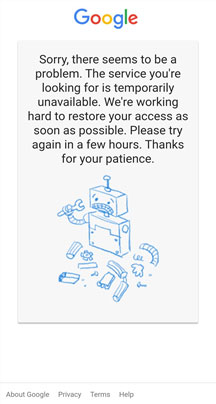
According to a study done by researchers at Harvard Business School, Wharton School and the University of Pennsylvania, people were more comfortable lending their cell phone to a stranger when he first apologized for the rain — something that was not at all in his control. Out of all people, only 9 per cent of them lent their cell phones minus the apology, but a whopping 47 per cent did when the person said sorry.
The researchers concluded: “Across our studies, we identify significant benefits to apologizing. Superfluous apologies represent a powerful and easy-to-use tool for social influence. Even in the absence of culpability, individuals can increase trust and liking by saying ‘I’m sorry’ – even if they are merely ‘sorry’ about the rain.”
This can be used very effectively to reduce user frustration and increase user satisfaction and trust. For example, if a company uses mail blasts that they are not aware will be useful to the user they should have a unsubscribe option for the user at the bottom, but that’s not all, chances are if the user has scrolled to the bottom and looked for the unsubscribe option he is already frustrated with these mails and intends to unsubscribe so how about apologising to the user for the frustration and irritation caused near this opt-out itself? So the user would receive an apology before he opts out which will reduce his negative feelings towards the experience and also boost his trust in the service as he realises the company is aware they have caused him an unpleasant experience.
If saying sorry isn’t your cup of tea, then you may want to change yourself for the better. Why? Because changed behaviour can prove to be more convincing. To explore the idea of trust recovery, scientists got a big group of volunteers to play an elaborate “trust game”. The research experiment went on to prove that people are more likely to forgive and trust again when they see the possibility of change. There’s no doubt about the fact that apologizing is the first step to making things right. However, doing something more can make a stronger impact.
Use these discoveries together for a much more powerful effect for example in the previous example where I suggested apologising to the user for causing them inconvenience, go one step ahead and tell the user you have understood this and will not disturb them again in the future. This will further increase their trust in you and will allow you a higher likelihood of retaining and earning more of their trust in the future.
17. Provide Flexibility and Freedom of Choice
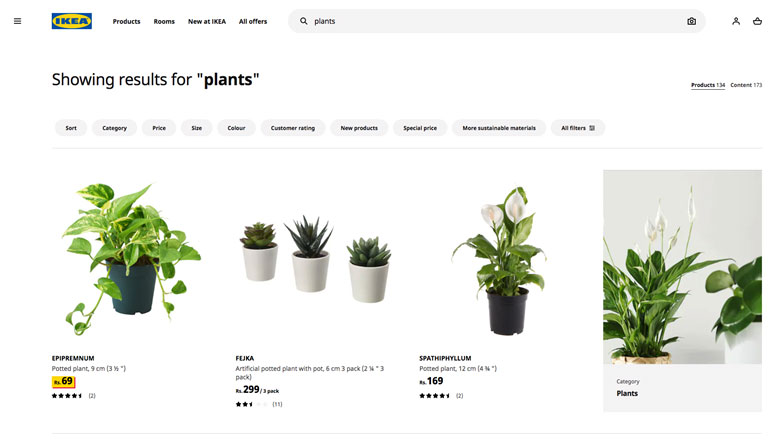
IKEA provides its users with a wide array of filters to search however they prefer.
Allow users, whenever possible, to manage tasks and execute them in their own way or at least provide multiple different ways to achieve an end goal.
A 2014 Citigroup and LinkedIn survey found that nearly 50% of employees would give up a 20% raise for greater control over how they work. This has also been successfully embraced by open-world games like GTA that allow users to complete tasks in any way they want. Similar behaviour has been observed in users performing tasks on digital interfaces, users tend to trust platforms that allow more flexibility more than those that do not. For example, different users like to search for food for their next meal through different means, some like to search and compare the ratings of specific dishes, some like to search and choose between meals of different prices, while some like to order based on restaurant ratings, etc. Providing this flexibility builds user’s trust in the fact that the product they are using trusts them to make the correct choice themselves while simply helping facilitate that decision as opposed to some apps that may not provide the flexibility of sorting food by calories for example making for a poor experience for users expectant of such a feature. The users trust in the capability of this app to let him complete his goals will drop.
Here are a few more interesting activities that have been known to boost oxytocin levels in humans that could be used to design a trustworthy experience for users:
1. Sharing a Meal
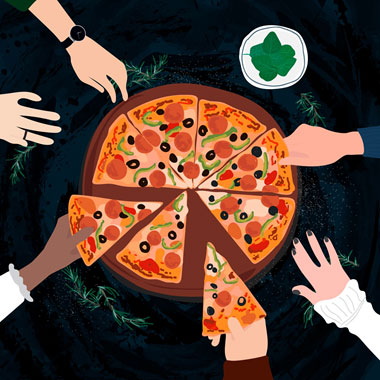
Research on chimpanzees has shown higher urinary oxytocin levels after single food-sharing events compared with other types of social feeding, irrespective of previous social bond levels. I hypothesize it is the same in humans as this is a form of socialising which has been shown to increase oxytocin levels. It makes sense too — sharing food is a great way to bond. Think back to your middle school or elementary days when splitting that cookie or packet of fruit snacks netted you a friend or two. This could be used effectively by dating/matrimony apps by offering two potential love birds who have shown interest in each other a discount to a nice place to eat so they can meet and build trust between each other to help take their relationship to the next level.
2. Listening to Music

A few small studies have found evidence to suggest music can help boost oxytocin levels in the body. According to a 2009 study 20 open-heart surgery patients who listened to music while on bed rest had higher levels of oxytocin and felt more relaxed than patients who didn’t listen to music. Music is used by a lot of apps to help entertain a user while he is performing a task to make it more interesting in games, tutorial videos, otherwise silent scenes in movies, etc
3. Meditating

Researchers believe that you give yourself a boost in oxytocin when you meditate and may even up-regulate oxytocin receptors.
It has been found that a form of meditation called “metta,” in which one focuses on loving others, is even better at fostering social connections than standard mindfulness meditation. While performing metta meditation, you repeat positive phrases to yourself, think positively of other people, and direct well-wishes and love towards them. For example, you could close your eyes, simply think about a friend or a family member, and repeat over and over that “they are wonderful”. Simply repeat this thought to yourself over and over, while pushing away any other negative thoughts that arise.
4. Yoga

Is a popular “mind-body” relaxation technique that increases the activity of your parasympathetic “rest and digest” nervous system. Researchers believe it works because it increases oxytocin levels in the brain by stimulating the vagus nerve.
How about next time you wait for your online food delivery, your meal delivery app simply helped you to perform a different yoga pose using a tutorial and even rewarded you with a small discount on your next order for completing it?
5. Smiling

According to a study by a group of scientists smiling makes you trustworthy. It showed that people who smile are seen to be more generous and genuinely helpful. Another research published in ScienceDirect revealed that a smile boosted people’s “willingness to trust” by about 10%. This is why it is useful to have smiling images of people on interfaces to make them, and indirectly the experience, feel more trustworthy.
6. Gifting
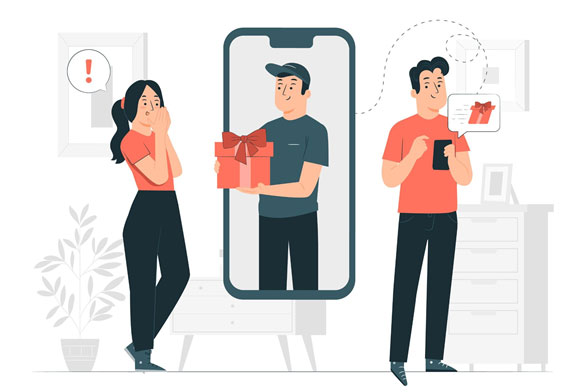
Human oxytocin studies have shown that receiving gifts raises oxytocin. Why not make this a regular practice? The key is to not expect a gift in return, just surprise someone for no reason. Ever received a surprise Gulab Jamun or something else you like in your tiffin? How did it make you feel? This is a prime example of doing small things to build trust and even love as oxytocin is also known as the love hormone. Imagine receiving a free slice of cake when you order food from a food delivery app on your birthday.
7. Eating Chocolate

Eating chocolate releases oxytocin and builds trust. Use the gift principle and chocolate principle for double effect. Give chocolate with each delivery and differentiate with your competition while building trust between your riders and your customers, this could become a hook for users to order from your delivery service. Users will even grow to be expectant of receiving chocolate when they order food and hence order from you. Give the user a choice of which chocolate they want, it doesn’t have to be expensive chocolate.
8. Running a Marathon
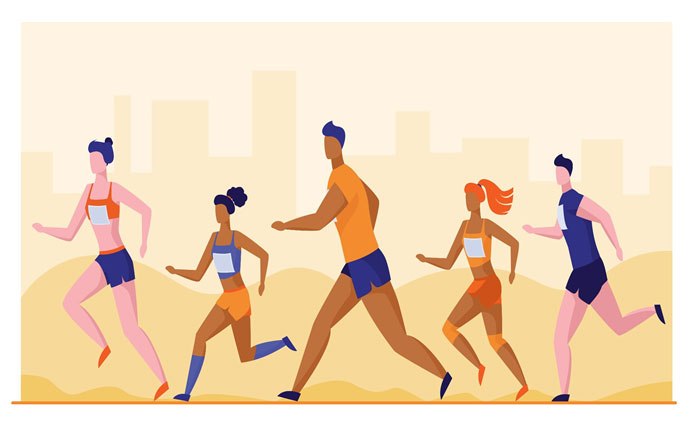
A 2008 study showed that ultramarathoners had temporarily elevated levels of oxytocin. So we can assume that our brains release oxytocin during long runs (exactly how long is not known). And animal studies have shown that exercise-induced oxytocin surges result in improved social bonding. This can be very useful to fitness applications as they could
Bibliography:
- https://www.stonybrook.edu/trust/documents/CPMarch04.pdf
- https://www.ncbi.nlm.nih.gov/pmc/articles/PMC3327534/
- https://hbr.org/2017/01/the-neuroscience-of-trust
- https://www.betterup.com/en-us/blog/3-research-backed-ways-to-build-trust
- https://www.psychologytoday.com/us/blog/the-moral-molecule/201311/the-top-10-ways-boost-good-feelings
- https://hbr.org/2009/06/rethinking-trust
- https://econpapers.repec.org/article/ecjeconjl/v_3a111_3ay_3a2001_3ai_3a470_3ap_3a295-321.htm
- https://www.ncbi.nlm.nih.gov/pmc/articles/PMC6784812//li>
- https://www.optimallivingdynamics.com/blog/25-effective-ways-to-increase-oxytocin-levels-in-the-brain
- https://news.rice.edu/2006/09/21/rice-study-suggests-people-are-more-trusting-of-attractive-strangers/
- https://www.socialmediatoday.com/news/7-research-backed-notes-on-how-brands-can-build-trust-on-social-media/531876/
- https://www.gallup.com/services/182138/state-american-manager.aspx
- https://www.ncbi.nlm.nih.gov/pmc/articles/PMC3832785/
- https://www.hindawi.com/journals/ahci/2018/5681652/
- https://citeseerx.ist.psu.edu/viewdoc/download?doi=10.1.1.379.8756&rep=rep1&type=pdf
- https://www.sciencedirect.com/science/article/abs/pii/S1090513807000645#!
- https://www.healthline.com/health/how-to-increase-oxytocin#listening
Image attributions:
- People vector created by freepik – www.freepik.com
- People vector created by pikisuperstar – www.freepik.com
- People vector created by stories – www.freepik.com
- Medical vector created by pikisuperstar – www.freepik.com
- Tree vector created by pch.vector – www.freepik.com
- Circle vector created by macrovector – www.freepik.com
- Heart vector created by alicia_mb – www.freepik.com
- Food vector created by rawpixel.com – www.freepik.com
- https://pixabay.com/users/pexels-2286921/?utm_source=link-attribution&utm_medium=referral&utm_campaign=image&utm_content=1867754
- Health vector created by pikisuperstar – www.freepik.com
- Background vector created by rawpixel.com – www.freepik.com
- People vector created by stories – www.freepik.com
- Food photo created by valeria_aksakova – www.freepik.com
- Business vector created by pch.vector – www.freepik.com
- People vector created by pch.vector – www.freepik.com
- People vector created by pch.vector – www.freepik.com
- School vector created by macrovector – www.freepik.com
- Handholding Illustration by Alex Angelich, University Communications, Virginia.edu





